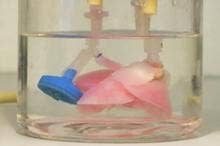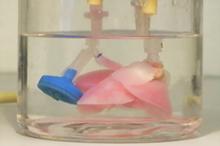Lungs Grown on Scaffolds Breathe After Transplantation in Rats

Share
Scientists have used the remains of old lungs to grow new ones capable of being transplanted. Researchers led by Laura Niklason at Yale University took a set of healthy rat lungs, stripped them of their cells, grew new cells upon them, and then placed them into a new rat. According to the results recently published in Science, the lungs breathed in the new rat and exchanged air for up to two hours. The removal and culturing of cells from organs (decellularization and recellularization) could one day allow any person to become a universal donor for transplant. This would help save the lives of thousands who die each year around the world waiting for a new lung. While it is still in its preliminary stages, this research is another success story in the growing field of regenerative medicine. Check out an overview of the experiment in the video below and don't miss watching the lungs breathe around 0:44 and 1:07.
This is only one of several attempts at constructing new organs on the scaffolds of old organs. In rats we've seen the same done for hearts, and very recently with livers. As with livers, the reconstructed rat lungs were capable of surviving in vivo. That's very impressive, but we've already seen better, and in humans, too. Entire tracheas have been grown using a similar method, and several transplants (two in adults, one in a young boy) have proven it successful. The lungs (and liver and heart) are considerably more complex than a trachea, which is why these examples of the technology are lagging years (perhaps decades) behind. Still, the accomplishments with tracheas gives me hope that building organs on scaffolds will eventually be able to work with more complicated organs in humans as well.
But what does building an organ on a scaffold actually entail? The organs in the body have what amounts to a 'skeleton' - a structural framework that lung (or liver, or heart, etc) cells grow on. This framework is comprised mostly of collagen, and unlike cells, does not differ greatly between individuals. Essentially these organ scaffolds can be transplanted from almost anyone into almost anyone else without most of the worries of rejection. Of course, a scaffold with no cells wouldn't be much help to anyone as it's the cells that actually perform the work of the organ. So cells taken from either the eventual host or some universal donor (such as fetal stem cells) are used to repopulate the scaffold and create a new healthy organ. This stripping down and building back up may seem like a lot of work, and it is, but it will allow an organ taken from a cadaver to be eventually transplanted into almost anyone.
Be Part of the Future
Sign up to receive top stories about groundbreaking technologies and visionary thinkers from SingularityHub.


The Yale researchers had some pretty promising results from this series of experiments. Culturing the new organs only took a little more than a week! Not only were they able to transplant the newly grown lungs into new rats, they got them to work for 45-120 minutes with about 95% of the efficiency of normal lungs. After their brief stay in the new rat, the lungs were removed so they could be analysed. The team also explored the durability of the new lungs (these things do have to move during breathing, after all) and found they were also nearly normal in strength. These are great first steps.
As always when I see medical science that is still using animal models, I'm fairly cautious about estimating when it may become available to humans. As part of the project, Niklason's group did decellularize and partially recellularize (in slices) a human lung from cadaver, but these tests were even more preliminary. Niklason herself, according to Technology Review, believes it may be twenty years before humans are using scaffold-grown lungs as transplants. For many that means this technique will simply not arrive in time for them to use it. Yet the current state of lung transplants isn't really that great to begin with - only 10-20% of recipients live more than ten years past the surgery.
Even if it takes decades to perfect, the scaffolding approach for culturing new organs seems very likely to become a widespread and useful technique. Yes livers and lungs are complex and will take a while to develop, but the heart muscle tissue is (a little) simpler and could be here earlier, and we've already discussed how scaffolds for simple vascular-like organs such as the trachea could become accepted science very soon. In the future, decellularization and recellularization of organs will mean that every organ donor, every cadaver possibly, will be able to save as many lives as possible. No organs will have to be wasted due to mismatched immune systems. That's a wonderful prospect, and a right step towards using science to replace and rebuild our bodies as they fail. Effective immortality here we come!
[image credit: Thomas Peterson and Laura Niklason]
[source: Technology Review, Wall Street Journal, Petersen et al, Science 2010]
Related Articles

This Light-Powered AI Chip Is 100x Faster Than a Top Nvidia GPU

This Week’s Awesome Tech Stories From Around the Web (Through December 20)

Data Centers in Space: Will 2027 Really Be the Year AI Goes to Orbit?
What we’re reading
